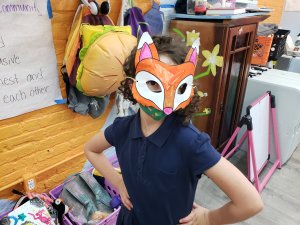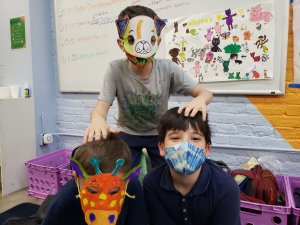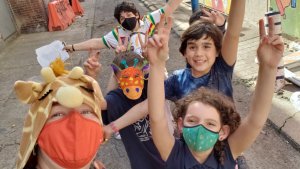Our learners have been busy exploring the story of Noach and playing with ideas of sanctuary, lawlessness, animal communication with God, and much more!
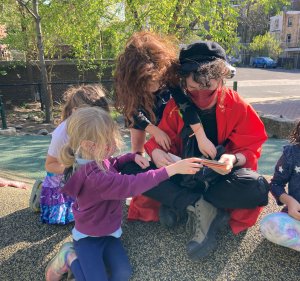
Garinim (kindergarteners) wondered about the Noach story:
- Why does the text say that people are nothing but evil? I don’t think that’s the way people are now.
- It’s really sad that Noach’s family is the only one to survive.
What might people have been doing that was so bad that God decided to destroy them?
- Punch each other a lot of times
- Stealing
- Hitting, kicking, and shoving
- Not being nice
What are some options we have when things are going poorly or when something is broken?
- Sometimes you can make something else out of it.
- Even if something is broken, you can still make it beautiful.
- Fix it!
- Throw it away and start over.

Torah tells us that Noach walked with God. Have you ever walked with God?
- I don’t know because I can’t see God.
- I walked with God once when I was out walking by myself.
- I know that I’m walking with God because God is everywhere.
Noach was supposed to bring pairs of animals onto the ark with him. We know that Noach knew to go on the ark because God talked to him. How did the animals know which of them should go?
- God invisibly pushed them.
- God talked to them because God knows all the animal languages.
- Noach made the right animals go on the ark.
- God had an invisible helmet to transmit instructions to the animals.
- God made a portal that attracted certain animals and then dropped them onto the ark from the sky.
- God’s responsible for making sure the right number of animals come to the ark, and then Noach is going to count them and send a letter to God — maybe by Mt. Sinai.
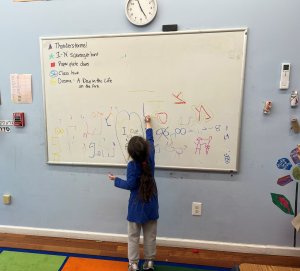
For our new and final unit: Awe and Wonder, Shorashim (1st-2nd graders) and Garinim have had Shulchanot Avodah (activity centers) together. This has been a lovely addition to our afternoon because the kiddos are able to experience new modalities and collaborate with kids who are not in their kevutzah.
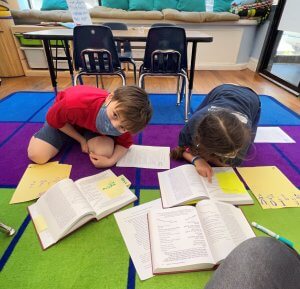
Each week, our shulchanot pertains to the week’s text and a Hebrew activity. This week’s Hebrew activity was an Aleph-bet Scavenger Hunt! Kiddos were explorers in the Makom Jungle, trying to find and identify all of the letters of the Hebrew Aleph-bet. It was the learners’ job to find a hidden letter, bring it to a teacher, identify the letter and sound, and then write the letter on the board with their explorer signature. It was definitely a silly activity but we were pleasantly surprised by how many students wanted to play and participate. Kids were searching all around the room shouting, “I got one!”, “where is the mem?”, or “what’s this letter?” This activity was also a great opportunity for Shorashim kids who have already written their Aleph-bet on the wall to help other kids who needed some help identifying the letters. Towards the end of the week, we lost our nun and the kids were determined to find it. They wrote the letter on the whiteboard so they wouldn’t forget what it looked like. To this day, we have yet to find it but we think the image of a nun is burned into the kiddos mind.
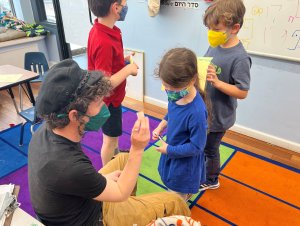

As we explore the Noach story, Nitzanim (3rd-5th graders) has been engaging in the themes and characters in so many fascinating ways. Throughout the telling of the bits of the story, kiddos have been drawing their own animals to add to our “Where’s Noach?” board, a spin-off of “Where’s Waldo?” Learners listed as many creatures as they could to draw, cut out, and paste onto our collage of animals. Once our ark is filled, we will place our little Noach character on different spots and challenge each other to find him in the sea of creatures.
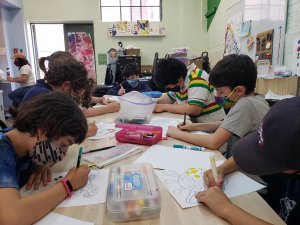
We came together to create our own visual, flood experience in the classroom by sculpting mountains, animals, trees, houses and even a little dog and put them in a small container. To replicate the flood waters engulfing earth by pouring kinetic sand over our creations.
We also unpacked this line from Bereishit, “(24) And when the waters had swelled on the earth one hundred and fifty days, (1) God remembered Noach and all the beasts and all the cattle that were with him in the ark, and God caused a wind to blow across the earth, and the waters subsided.” Kiddos took a deeper dive into the Hebrew word for remember, zachor. As the waters swelled on earth for the 150th day, God remembered Noach and the ark. What helps Nitzanim remember that they are part of a Jewish community? What helps them remember fond memories and/or being a part of a Jewish community?
- My cat
- My blue necklace from my mom
- A smiley face
- A heart
- A tree
Using pointillism, or painting with colorful dots, learners wrote words and images that help them remember, surrounded by the word zachor on their papers.
To celebrate the exit from the ark, we created our own animal masks and put them on before swarming the alley to populate the land, just like the animals did. It was a real moment of awe and wonder to watch the Nitzanim flood the alleyway with their joy.
